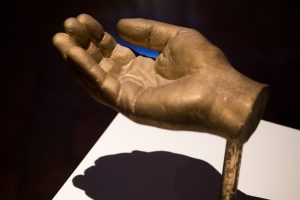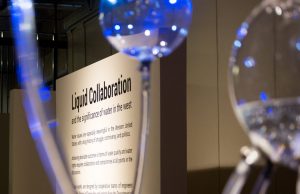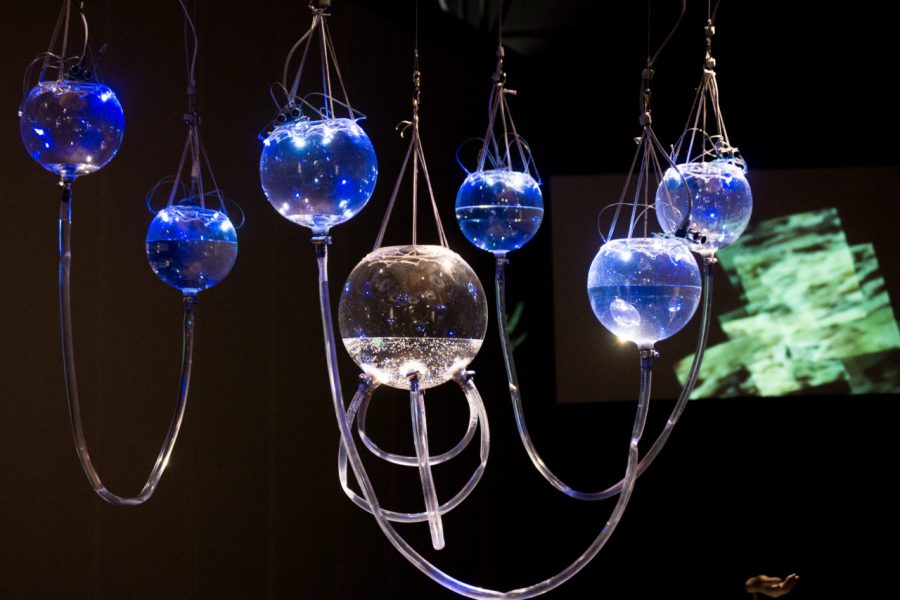Dark, static sound permeated the room where “Liquid Collaboration” was installed in the Gittins Gallery from Feb. 2-17. A screen on one wall seemed to vibrate with images as static as the sound.
Water was everywhere, and yet at the same time hardly there at all. Though featured in of the three pieces, the life-giving liquid we depend on for survival was overshadowed by the often mechanical containers holding or portraying them.
Each piece was unique, and all caught the eye.
 The static exuded from the piece situated farthest from the exhibit’s entrance. Images on a screen were chaotic, frenetic and it’s unclear what they were meant to be. Before it sat two hands — or bronze casts of them, anyway. The meaning of this work, titled “Collective Currents,” is indiscernible alone. Groups held hands between the casts to form a living chain that changes images on the screen, becoming clearer until a stream is clearly visible even as the static sounds turn to those of a burbling brook. Collaboration is here prized as a way to combat water issues facing the United States in particular today.
The static exuded from the piece situated farthest from the exhibit’s entrance. Images on a screen were chaotic, frenetic and it’s unclear what they were meant to be. Before it sat two hands — or bronze casts of them, anyway. The meaning of this work, titled “Collective Currents,” is indiscernible alone. Groups held hands between the casts to form a living chain that changes images on the screen, becoming clearer until a stream is clearly visible even as the static sounds turn to those of a burbling brook. Collaboration is here prized as a way to combat water issues facing the United States in particular today.
Another screen lined the right-hand wall, with images distinguishable even if they didn’t instantly make sense. A geometric earth, incomplete images of blue and pink, and an eye were complemented by sounds, discernible through the headphones placed on two white ottomans before them. These sounds are reminiscent of water dripping, of a mic buzzing, of rain; but with some significant alterations. Nearby, an entirely functional water cooler, painted in mostly shades of green, with occasional splashes of color and filled halfway by the last visit, was placed next to a recycling bin and a container of paper drinking cups. The work is titled “Words are Water,” with the audiovisuals given the name of “Jörmungandr” which is a mythological world-devouring Nordic creature. Both the water in the cooler and the sounds were sourced from actual glaciers, emphasizing the destruction that happens for the sake of human survival.
Featured prominently midway through the room were water-laden spheres dangled attached to one another via clear tubes. Mechanical devices topped many of these spheres, watching viewers’ movements. As viewers move closer to any one sphere, that sphere moves higher, so that its water drains into another sphere to which it is most closely connected. A triangle of sand decorates the floor immediately below this piece, titled “Casual Nexus.” The message here is on the global effects of water issues in one area; whenever water is taken from or added to one place, it has a lasting effect on the water availability in another.
Besides water, there was one other component to this exhibit that could be found in every piece: cross-departmental collaboration between artists, computer scientists and engineers.
Three partnerships made this exhibit possible. For “Collective Currents,” the artist was an assistant professor in the Art & Art History Department, Wendy Wischer, and the computer engineer was Erik Brunvand. “Words Are Water” developed from a collaboration between artist Justin Watson and computer engineer Tim Grant. Work between artist Tatiana Larsen and computer scientist Peter Jensen led to “Casual Nexus.”
While collaboration can be difficult, collaboration between people who have learned to think in entirely different ways by pursuing traditionally separated programs is on another level of difficulty entirely.
Like Wischer, Watson and Grant, Brunvand has a connection to the University of Utah as the director of the computer engineering program as well as an associate professor in the School of Computing. “It’s a mindset change for engineers in particular,” Brunvand said, explaining that computer engineers and scientists are used to finding the solution and moving on, not finding the solution and then refining it until it’s ready for public presentation as is necessary in art fields.
Watson is a graduate from the U with a BFA and MFA in Sculpture and Intermedia. He noticed this difficulty as he worked with Grant. “It was pretty interesting working with someone who comes from an entirely different field,” he said.
 This collaboration component was inspired by “9 Evenings,” an event that took place over 50 years ago in October, 1966 in New York City. The event was remarkable for its groundbreaking mix of art and technology on such a grand scale, the first one of its kind. Though deeply impactful in its proof that art and technology can — perhaps, even, should — work together, something seems to have happened that limited its effect in today’s world. Somehow, artists and tech workers like computer scientists and engineers are still questioning their ability to collaborate. “It’s a little surprising that […] we’re still having the same conversation,” Brunvand said. “Somehow we’ve lost this strong connection between humanities and scince […] it’s a shame.”
This collaboration component was inspired by “9 Evenings,” an event that took place over 50 years ago in October, 1966 in New York City. The event was remarkable for its groundbreaking mix of art and technology on such a grand scale, the first one of its kind. Though deeply impactful in its proof that art and technology can — perhaps, even, should — work together, something seems to have happened that limited its effect in today’s world. Somehow, artists and tech workers like computer scientists and engineers are still questioning their ability to collaborate. “It’s a little surprising that […] we’re still having the same conversation,” Brunvand said. “Somehow we’ve lost this strong connection between humanities and scince […] it’s a shame.”
Even so, these collaborations still happen. October 2016 marked a revival as a way to honor the “9 Evenings’” impact. “Liquid Collaboration” was similarly inspired by people long interested in such collaboration, though it is not an attempt to recreate that time, but to act in its spirit.
Wischer and Brunvand acted as the motivating forces for “Liquid Collaboration.”
“It started out as a collaboration with Erik,” Wischer said. “[This collaboration] allows for a greater understanding of the other discipline as well as the differences between discipline [and] opens up possibilities for future collaboration, and how that can work.”
Brunvand agreed, explaining that his interest in this work was not new. “I’m also very interested in arts and technology collaboration,” he said. “I’ve been interested in how art and technology work together for a long time.”
From their initial interest, they decided to try engaging others. They put out a call for interested artists and tech folk within their respective departments. Once a few people reached out, they began organizing a dinner to allow members of the different departments to meet before anyone would be asked to start working with a partner. Not everyone who attended the initial event ended up producing something for the final exhibit, but after a time Watson, Grant, Larsen and Jensen were in pairs and starting their projects.
For Watson, conversation was key in making this work, and this idea worked itself into the design of his and Grant’s piece. “Conversation became very important to the design, but also to the process,” he said. “Not only a physical conversation, but a virtual conversation too,” he added, referencing the many emails the two sent to one another as the piece was coming together.
In many ways, this collaboration is part and parcel to the water theme of the exhibit. Brunvand said, “We thought about water as a unifying theme; especially in the United States, water is a critical resource.”
As it says on a statement about the exhibit, “Achieving desirable outcomes in terms of water quality and water rights requires collaboration and compromise at all points in the discussion…This interactive installation…explores the idea of cooperative experience in both literal and conceptual ways to create a unique environment that references our ability to understand and solve environmental issues, specifically clean water, through collaboration.”
@casey_koldewyn


